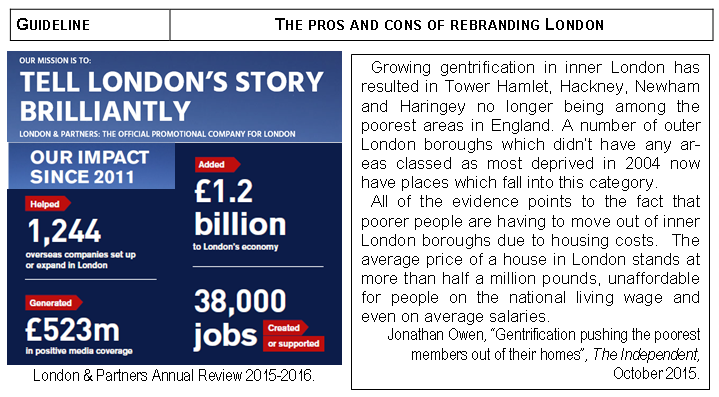![]() REBRANDING LONDON
REBRANDING LONDON
Method 2: Commenting on 2 documents

Stage 1: Introduction - Presenting the documents
Similarities: Both documents deal with the rebranding, that is to say renovating & re-imaging a city, so on a local scale, here London the capital city of the UK, a dvped country.
Differences: The ad by London & Partners from its 2015-2016 annual review shows the company’s positive impact and the article from the Independent published in October 2015 by Jonathan Owen describes the impact of gentrification.
Announce structure: In In a 1st part I’ll focus on the advantages + aspects & in a second part I’ll analyze the drawbacks negative elements.
Stage 2: Analysing the documents
| DESCRIBE THE DOCS - What you see Structured and detailed description |
INTERPRET THE DOCS - What you know Add & structure definitions of key notions |
| 1. The asset: an economically attractive city, thanks to the ad | |
- Social impact: |
Re-imaging : to “sell”, promote a new positive image, using advertising, marketing |
| 2. The downside: the social cost of regeneration, using the article | |
| P1 Description: Londoners migration Gentrification of inner London => higher standard of living But deprivation moved to outer London P2 Explanation: the reason for this move Low-income groups left due to higher cost of housing and living indeed housing prices above average income |
- Inner gentrification: high-income groups back to the inner-city after its regeneration (def) with higher standard of living and quality of life - Outer deprivation: eco poverty, social exclusion & enviro dereliction due to suburbanisation of low-income groups => a new form of segregation, a polarised, divided & not an inclusive city |
Stage 3: Concluding
Assess docs (reliable/biased justified): To conclude, these documents are reliable as we have their full references, and both are biased: the ad is focusing on positive impacts to promote the city and the article describes a new segregation ; so globally they are balanced (+ & -).
Sum-up ideas (+ nuance/opening): Both docs show that re-imaging has a positive eco impact but regeneration has its social downsides => mixed effect of rebranding a city, so not really sustainable. We may wonder if the situation is similar in another global city like New York.